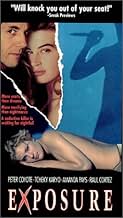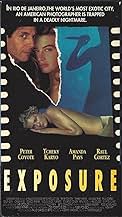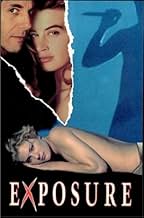CALIFICACIÓN DE IMDb
6.1/10
818
TU CALIFICACIÓN
Agrega una trama en tu idiomaAn American photographer in Rio de Janeiro becomes involved in the world of "knife culture" when he sets out to find the killer of one of his models.An American photographer in Rio de Janeiro becomes involved in the world of "knife culture" when he sets out to find the killer of one of his models.An American photographer in Rio de Janeiro becomes involved in the world of "knife culture" when he sets out to find the killer of one of his models.
- Dirección
- Guionistas
- Elenco
- Premios
- 4 premios ganados en total
Tchéky Karyo
- Hermes
- (as Tcheky Karyo)
José René Ruiz
- José Zakkai - Iron Nose
- (as Rene Ruiz)
Miguel Ángel Fuentes
- Camilo Fuentes
- (as Miguel Angel Fuentes)
Cássia Kis
- Mercedes
- (as Cassia Kiss)
Alvaro Freire
- Evilásio - Mitry's Butler
- (as Álvaro Freire)
Opiniones destacadas
The first scene of the film is brilliant!!!! A hooker is murdered. One reporter, his friend, decide to try to find her murderer and finds a lot of different friends, places, situations that weren't expected. Specially, a "master" of knives..... Script, scenarios, photography are perfect and make a perfect match.
This is a well made, low key thriller about knife fighters in Rio. Peter Coyote gives one of his best performances. The only quibble I had with the film is that I wanted to see A WHOLE LOT MORE KNIFE FIGHTING!
After all that great, cool set up and the main character undergoing the Art of Knife Fighting training. I was a bit disappointed we didn't get many more knife fights. This could have been the ultimate knife fighting movie. Still, it's good. But when during the final fight sequence I wanted something more spectacular, blood spraying to the heavens like the end of Kurosawa's Sanjuro. And after seeing the extraordinary knife fighting sequence in Kill Bill I was expecting a little more.
After all that great, cool set up and the main character undergoing the Art of Knife Fighting training. I was a bit disappointed we didn't get many more knife fights. This could have been the ultimate knife fighting movie. Still, it's good. But when during the final fight sequence I wanted something more spectacular, blood spraying to the heavens like the end of Kurosawa's Sanjuro. And after seeing the extraordinary knife fighting sequence in Kill Bill I was expecting a little more.
A film that is extremely evocative - so many exciting nuances. It is unforgettable - a pity that the actor who played the "knife expert" is seen more. One of Peter Coyote's best.An unusual cast - many contrasts. The photography is outstanding. A haunting experience....
I believe this oddly successful film was also aired on US television (Bravo channel) as "Exposure". I have never seen it under the other titles listed. The knife techniques are very professional and effective, as is the explanation of selection of weapons.
10scvanv
Fighting with edged weapons fell into obscurity after the advent of the gun. The old European blade skills almost died out, as did the Oriental arts of Arnis, Escrima, and Silat(which were derived in part from the fighting art of the Spanish Conquistadors).
The science of blade fighting smoldered weakly for five hundred years in remote outposts of Indonesia, the Philippines and Japan where the gun never quite captured the imagination of peoples who had truly understood steel.
Recently, for reasons which are still obscure, blade skills have enjoyed a renaissance as a legitimate martial art in the United States. A sub-culture of knife fighting students has emerged which will be the audience of this excellent movie.
This film stands almost alone as an artistic representation of training and fighting with edged weapons. Early in the movie Tcheky Karyo carries off a chilling and realistic knife-fighting sequence which makes the hair stand up on the neck. He then plays the instructor, showing the viewer the simple beauty of how an art thousands of years old can be transmitted.
Peter Coyote makes us see the mental and physical journey of the student. At the climax of the movie he manages to project truly the mind-set needed to face steel with steel as he goes toe-to-toe with the true master in a duel to the death.
The training sequences in this movie are clear expressions of real techniques used in the old arts of Arnis and Escrima, with elements of European blade practice thrown in. The film could actually be studied as a training aid.
A certain amount of "Hollywood" was included to extend the final fighting sequence for dramatic effect, but this will not be noticed by the novice and should not interfere with the enjoyment of any viewer interested in the arts involved.
This film is an example of the movie being better than the book. Rubim Fonseca's book "The High Art" contained only the germ of the grim plot which the movie fully exploits. For some reason, after having his character learn the high art, Fonseca has him put the knife away in a drawer and back away from the brutal reality of the science he has learned, contenting himself with amorous conquests rather than the quest for vengeance which was the real core of the book.
This movie will have a limited but loyal audience for many years. It is sad that there will probably never be a DVD version in which the frames could be stopped to better understand the science involved.
The science of blade fighting smoldered weakly for five hundred years in remote outposts of Indonesia, the Philippines and Japan where the gun never quite captured the imagination of peoples who had truly understood steel.
Recently, for reasons which are still obscure, blade skills have enjoyed a renaissance as a legitimate martial art in the United States. A sub-culture of knife fighting students has emerged which will be the audience of this excellent movie.
This film stands almost alone as an artistic representation of training and fighting with edged weapons. Early in the movie Tcheky Karyo carries off a chilling and realistic knife-fighting sequence which makes the hair stand up on the neck. He then plays the instructor, showing the viewer the simple beauty of how an art thousands of years old can be transmitted.
Peter Coyote makes us see the mental and physical journey of the student. At the climax of the movie he manages to project truly the mind-set needed to face steel with steel as he goes toe-to-toe with the true master in a duel to the death.
The training sequences in this movie are clear expressions of real techniques used in the old arts of Arnis and Escrima, with elements of European blade practice thrown in. The film could actually be studied as a training aid.
A certain amount of "Hollywood" was included to extend the final fighting sequence for dramatic effect, but this will not be noticed by the novice and should not interfere with the enjoyment of any viewer interested in the arts involved.
This film is an example of the movie being better than the book. Rubim Fonseca's book "The High Art" contained only the germ of the grim plot which the movie fully exploits. For some reason, after having his character learn the high art, Fonseca has him put the knife away in a drawer and back away from the brutal reality of the science he has learned, contenting himself with amorous conquests rather than the quest for vengeance which was the real core of the book.
This movie will have a limited but loyal audience for many years. It is sad that there will probably never be a DVD version in which the frames could be stopped to better understand the science involved.
¿Sabías que…?
- TriviaFeature directorial debut for documentary filmmaker Walter Salles Jr.
- ErroresThe knife dealer says the Applegate-Fairbairn knife is used by British commandos. Actually the knife is a redesign of the Fairbairn-Sykes fighting knife that was widely used in WWII, the Applegate-Fairbairn wasn't issued to any armed forces to this day.
- Citas
Peter Mandrake: All my life, I've been looking for something... different.
- Versiones alternativasUK versions are cut by 19 seconds for an '18' rating.
- ConexionesFeatured in Logos de Todo el Mundo: United States of America (aka 'Murica) (2016)
- Bandas sonorasThe Photographer (A Gentleman's Honor)
Written and Arranged by Philip Glass
Orchestra conducted by Michael Riesman
Courtesy of CBS Records
Selecciones populares
Inicia sesión para calificar y agrega a la lista de videos para obtener recomendaciones personalizadas
- How long is A Grande Arte?Con tecnología de Alexa
Detalles
Taquilla
- Total en EE. UU. y Canadá
- USD 356,825
- Tiempo de ejecución
- 1h 44min(104 min)
- Color
- Mezcla de sonido
- Relación de aspecto
- 1.85 : 1
Contribuir a esta página
Sugiere una edición o agrega el contenido que falta




























